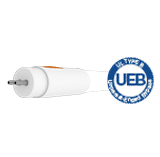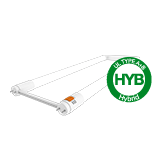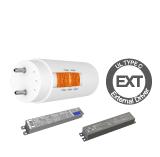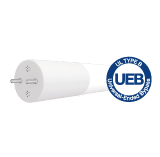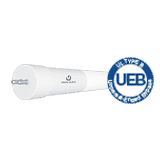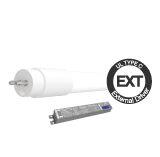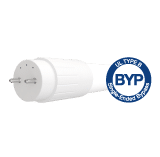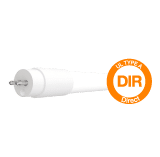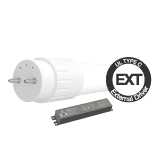Along with the development of LED technology, more and more linear fluorescent lamps are replaced by the more energy efficient LED tubes. But not all the re-lamping task is as simple as just removing the existing lamp and plugging-in the new LED version. Choosing from massive LED tubes with various electrical constructions and from different manufactures could be a puzzle work. Understanding the different types of LED tubes out there and what are the benefits and drawbacks of each type is key for making the right lighting decisions for your re-lamping project.
Definitions of Linear LED types in UL 1993
Type A
A device for general-use intended for direct substitution of a fluorescent lamp and operating from the ballast that would be provided for the fluorescent lamp without additional modifications of the fluorescent lamp circuit.
Type B
A device for special-use intended for operation in luminaires that are either factory wired especially for the device or as a component for retrofit luminaire conversions involving modification of an existing luminaire, and the LED driver components are an integral part of the device.
Type C
A device for special-use intended for operation in luminaires that are either factory-wired especially for the device or as a component for retrofit luminaire conversions involving modification of an existing luminaire, and the LED driver components are remote from (or not an integral part of) the device.
Quick view of each type considering cost, convenience and performance
Text | Type A | Type B | Type C | |
Description | DIRect replacement. | BYPass installation. | EXTernal LED driver involved. | |
Cost | Lamp Cost | $ | $$ | $$$ |
Installation Cost | $ | $$ | $$ | |
Operation Cost | $$$ | $$ | $ | |
Maintenance Cost | $$$ | $ | $ | |
Convenience | Installation | |||
Maintenance | ||||
Performance | Compatibility | |||
Reliability | ||||
Control Flexibility | ||||
System Efficacy | ||||
Considerations of Type A LED tube

— PROs —
- Lowest initial cost. Type A TLED operates utilizing the existing fluorescent ballast. No additional wiring or replacement of the ballast is required, thus almost no cost of labor for installation needed. Price of Type A lamp is also usually lower than other types in the market.
- Quickest installation. Just Plug & Play! Type A TLED does not require mechanical or electrical changes to the existing fixture. Just remove the fluorescent lamps and put the retrofit LED tube, and its done!
- Possible dimming function. Some of Type A TLED can be dimmable depending on compatible ballast used and dimming compatibility performance.
— CONs —
- Extra maintenance effort and cost needed in the long run. Most of the existing fluorescent ballasts have been used for a long time thus are not as stable as they should be. Replacement of ballast may be needed during the usage of the lamps.
- Overall system efficacy is low thus the operation cost is high. The fluorescent ballast will cause extra loss of electrical power, then lower the total efficiency of the system using Type A LED tubes.
- Compatibility and reliability issues. There are hundreds of types of existing fluorescent ballast in the field and one Type A LED tube cannot operate on all of them. Compatibility between lamps and existing ballast must be checked before installation. Not to mention one re-lamping projects may involve multiple types of ballasts in the field and some of them are not even known before the re-lamping start.
Considerations of Type B LED tube

— PROs —
- Minimal maintenance efforts or cost. Type B LED tube has integrated driver inside the lamp, and do not operate utilizing the existing fluorescent ballast nor external LED driver. Almost no maintenance cost or efforts need to consider before the end of the lamps’ lifetime during usage.
- No compatibility issues. With the integrated driver, Type B LED tubes can be directly wired to the line voltage, so no worries about the incompatibility with existing ballast for installation.
- Multiple ended solutions available for BYPASS tubes – single ended or double ended.
- More energy efficient compared to Type A LED tubes.
— CONs —
- High initial cost and complex for installation. Type B LED tubes are higher priced than Type A LED tubes usually. And initial installation of Type B LED tubes requires rewiring of the existing fixture to bypass the ballast and send line voltage directly to the lamp holders. Re-lamping could only be performed by professional electricians.
- Lack of dimming flexibility. Most Type B LED tubes are not designed to be dimmable, which make them not suitable for most dimming applications.
Considerations of Type C LED tube

— PROs —
- Dimming and control flexibility. Type C LED tubes work with 0-10V external LED driver. This electrical construction allows most flexibility for dimming as well as other control systems compared to other types.
- Best system efficacy and performance. With additional dimming and control possibilities, the lighting system of Type C LED tubes enjoy best overall efficiency for energy saving and superior lighting performance.
- No compatibility issues and good reliability. Type C LED tubes do not operate utilizing existing fluorescent ballast, but use separate drivers developed for LED light sources. No compatibility issues involved in re-lamping installation. The dedicated LED driver are also more reliable during the operation in the whole lifetime of the lamps.
- Low maintenance cost in the long run. No replacement of dead fluorescent ballast needed during the usage.
— CONs —
- Highest initial cost. It requires rewiring for additional external driver in initial installation, thus re-lamping must be performed by professional electricians. The total cost of Type C LED tube plus driver is usually higher than initial lamp cost of other types as well.
- Complex installation. Installation of Type C LED tubes requires rewiring of the existing fixture to replace the ballast with an external driver and wire the lamp holders accordingly.
Hybrid Type – Mix of UL Type A and Type B

Another type of LED tube existing in the market is a Hybrid Type, which is a mix of UL Type A and Type B. Hybrid Type LED tube operates utilizing the existing fluorescent ballast if compatible. At the same time, it can also operate utilizing line voltage if the fixture is rewired to bypass the ballast. Thanks for the flexible electrical design, either installation could be chosen in the field depending on the preference of the re-lamping project. Or after the existing fluorescent ballast running out of life, the LED tube could still service by bypassing the dead fluorescent ballast and connect the fixture to the mains voltage directly.
GREEN CREATIVE offers all the types of LED tubes
Each type has its own pros and cons, to meet different needs of our customer, GREEN CREATIVE offers a wide and comprehensive range of products for meeting various needs of our customer in different re-lamping projects.



